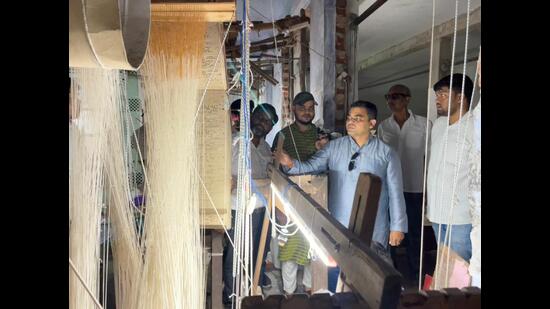U.P. looks to improve mulberry cultivation as silk exports grow by leaps and bounds
At present, the state is only able to fulfil a little more than one-tenth of its annual demand of 3,000 metric tons. To meet the rest, it depends on silk supplied by other states and countries.
With Uttar Pradesh witnessing impressive growth in the export of silk products since the last decade, the state’s department of sericulture has linked around 400 farmers to mulberry cultivation in an attempt to ramp up silkworm rearing and increase the production value in Varanasi and its adjoining districts.

Sunil Kumar Verma, the director of Sericulture Development, said: “The annual export of silk products has risen by 28 times due to various schemes of the state government and the Centre in the last nine years. The export value has increased to ₹250 crore from ₹9 crore nine years ago.”
While around 30,000 families in the state make a living out of its production, U.P. has an estimated 2.5 lakh weavers of silk products.
While mulberry silk is produced mainly in Saharanpur, Kushinagar, Deoria, Etawah, Auraiya and Unnao, tussar silk (also made from silkworms) is produced in Sonbhadra, Jhansi and Lalitpur districts.
Woven in Varanasi and Mubarakpur of Azamgarh, silk ties, scarfs, handkerchiefs and Banarasi sarees are high in demand in Europe. Silk carpets, which are prepared by craftsmen in Bhadohi, are liked in the Arab countries. The global demand for these products is one of the few factors that resulted in the silk export jump.
Verma added: “The One District One Product (ODOP) scheme has contributed immensely to this export growth. There is a huge potential for silk production in Uttar Pradesh and the department of sericulture is continuously working to meet the demand.”
Also, the state is only able to fulfil a little more than one-tenth of its annual demand of 3,000 metric tons. To meet the rest, U.P. depends on silk supplied by other states and countries.
The department’s assistant director for Varanasi and adjoining eight districts, Nagendra Ram, said, “As many as 400 farmers in Ghazipur and Jaunpur have been linked to mulberry cultivation for silkworm rearing. This work has been done through an NGO.”
Simultaneously, efforts were on to increase mulberry farming in Bhadohi and Azamgarh, he added. As a part of it, the department is also planning to train weavers of Varanasi and adjoining areas in scarf and tie designing since their demand is high in the international market.
Master weaver Azim Babu said mainly five types of silk, including mulberry, munga and tussar, were used by weavers. “Most of the silk yarn for sarees comes from Karnataka and other states because there is a huge gap between demand and supply in our state. It is good that the state government is making efforts to give a boost to the production of silk. It will be beneficial for weavers here,” he added.






